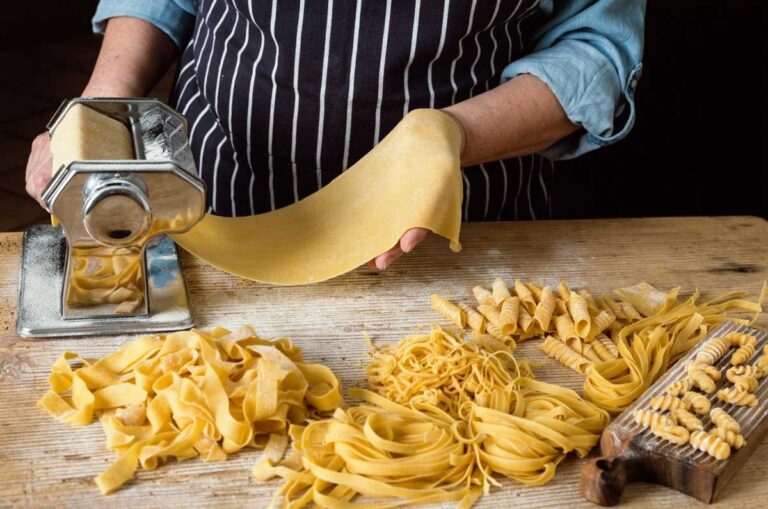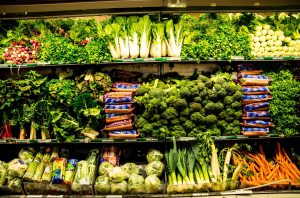Originally, Italian fresh pasta was made to be eaten right away, while dried was ideal for transportation and storage. Of course now-a-days we can have the best of both worlds: fresh frozen pasta, with all the delicious taste and texture of fresh home pasta combined with the convenience of dried.
While we’re partial to fresh pasta — all our pastas are fresh frozen — each type has unique characteristics and each has its place in the world of cooking. In this article we break down the differences and explain how each shines when it is used in the right recipes.
The History Of Convenience
Fresh pasta is an ancient food. In Europe, an Etruscan tomb dating back to the 4th century BC depicts people making what seems to be pasta. With its simplicity and versatility it only makes sense.
The first record of dried pasta in Italy dates back to 12th century Sicily — some say it was brought over by the Arabs. Soon after, pasta factories started popping up in Naples, where the sunny climate and low humidity was ideal for drying pasta. With the industrial revolution, pasta manufacturing became mechanized and pasta was mass produced. Since dried pasta has a long shelf life (at least 2 years) and is easy to ship, it became a staple in many countries.
For the longest time, fresh pasta in Italy, lovingly prepared, was seen as a treat for special occasions. Not many people have the time to make pasta at home and it only keeps for 2 to 3 days in the refrigerator. However, with fresh frozen pasta, every day can be a special occasion! Because our filled pasta is frozen within 4 minutes of it being made, Let’s Pasta retains all its freshness and goodness. Even better, it can be cooked straight out of the freezer, taking about the same or even less time to cook than dried pasta.
Ingredients of Each

At heart, Italian pasta is a very simple food. True, that makes it the perfect medium for experimentation, and over the years pasta has been made with different types of grains or even lentils and with the inclusion of squid ink or vegetables such as spinach and tomato to change its colour and flavour.
But at base, pasta is made with just two ingredients: durum wheat flour and water for dried pasta and hard or soft wheat flour and eggs for fresh. While the difference between dried and fresh is only an egg, it makes a huge amount of difference in texture, taste and how each is used.
Texture and Taste of Each
Fresh pasta has a silky texture, a lovely golden shade, and a rich, eggy flavour. It is soft and delicate and only needs to be cooked for 2 to 3 minutes in boiling water.
Dried pasta is firmer and holds its shape well allowing for an al dente texture when cooked just right. Because it is dried it needs a longer cooking — about 10 minutes generally.
Uses of Fresh vs Dried Pasta
Because of the completely different taste and texture profile, fresh and dried pasta are best in completely different recipes. Pasta can be thought of as the vehicle for the sauce, and matching the type and shape of the pasta to the sauce is part of the artistry of cooking pasta.
Fresh pasta, with its delicate texture and refined flavour, pairs especially well with sauces that highlight its fresh quality. Light sauces such as a pesto, Aglio olio (red pepper, garlic, olive oil) or sauces that use seafood pair very well with fresh pasta. The gently eggy flavour is brought out by creamy, butter-based sauces such as a Carbonara or our recipes for Minty Creamy Pancetta or Creamy Mushroom Sauce. And of course, as our ravioli and tortellini selection reveals, fresh pasta offers a deliciously exquisite wrapping for a variety of stuffings.
Dried pasta can handle heavier, meat sauces such as a bolognese and still hold its shape. If you prefer to go vegetarian, try our Roasted Mediterranean Vegetable recipe for a flavour-filled companion for dried pasta. Recipes that call for a longer cooking time often use dried pasta.
So which is better…
It depends. Fresh pasta is best for light, delicate sauces and dried pasta is best for hearty sauces or recipes that require a long cooking. Dried pasta is still the most convenent, — no freezer needed. But our fresh frozen pasta cooks faster, narrows the convenience gap while delivering the unique, delicate flavour of fresh pasta that used to take hours of slaving in the kitchen to produce.





